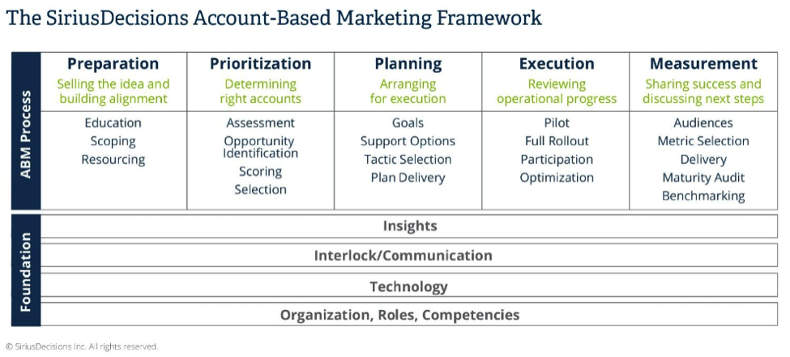Account-based marketing ( ABM) has taken marketing by storm. Buyers have become increasingly intolerant of irrelevant, badly timed, interruption-based tactics. ABM offers the promise to add relevance, differentiation, and value-add to the buying experiences, in turn building credibility, trust, marketing efficiency... and more sales.
But despite their best efforts, some marketers are frustrated that they're not seeing expected results from ABM and can't seem to pinpoint where they're going wrong.
The issue: their cultural and technological foundation.
If your organization is experiencing frustration, there's likely a crack in your foundation that's undermining your ABM strategy.
This article, will explore how to diagnose six common issues and offer ways to fix them.
1. There's friction between Sales and Marketing
In successful account-based programs, marketing and sales teams work together, hand-in-glove, throughout the buyer journey, to deliver a relevant and personalized end-to-end experience to a defined set of agreed-upon companies. That requires working together in new ways, strong leadership, and change-management training.
Signs of trouble: Your teams aren't working well together. Your sales team doesn't want the marketing team to look at what they're writing to prospects. Leads aren't getting enough follow-up. Efforts are misaligned.
How to fix: Effective programs require deliberate strategizing, planning, and orchestration between teams. Setting out with a shared vision, goals, aligned incentives, clear focus, roles, etc. will equip team members to collaborate with ease. To get on the same page, consider following the SiriusDecisions ABM framework. It provides a great outline of the necessary steps to take across Sales and Marketing to build a solid ABM foundation. It outlines what needs to get done and allows you to determine who should do which parts.

2. Your goals are unclear or misaligned
Getting ROI from your efforts starts with knowing what kind of return you are expecting... and when.
Signs of trouble: Sales leaders feel that Marketing is not doing enough. Marketers have no way to measure the success of their contributions. Marketing doesn't know where to invest next.
How to fix: Set your ABM goals together with Sales and use the goal-setting process to drive your program design:
- Are you trying to build a pipeline and need meetings for account executives?
- Do you need to reach higher-ups in your accounts?
- Do you need to get more exposure across your customer accounts?
Answering those questions together is critical because a shared vision of success with Sales will ensure that you're celebrating your wins and developing programs that will lead to each other's success.
3. You're not sure which accounts to focus on
With no shortage of businesses to target, knowing where to start can be a challenge. Or, even if you have a starting point in mind, it can be hard to shake the feeling that you're leaving money on the table by focusing on only a few companies.
Signs of trouble: Arbitrarily coming up with a wish list of desired logos and expecting Marketing to magically build demand is the surest way to burn through your resources without getting any results.
How to fix: Follow the interest... and the money. An ABM strategy requires focus on accounts that match your ideal customer profile, that have needs you can serve, and that are willing or interested to do something about it soon. Start by developing a shared understanding of your ideal customer profile (ICP) based on your best customers, and collaborate with Sales on account/cluster specifics if you have several segments to go after. Share any intent and account profile data you have (from your website's anonymous visitors, program engagement, and third-party data services such as Bombora or HG Data) to show Sales where there may be interest and potential.
4. You can't reach buyers
The success of your ABM strategy will largely depend on your ability to reach your target audiences. Without a good understanding of whom you're targeting, trying to reach them with outdated tactics will continue to be a challenge and a waste of money.
Signs of trouble: You're still running blanket banner ad buys, unpersonalized email programs, and generic field marketing, all of which used to work in the past but are now showing signs of fatigue. You're not investing in new methods to reach people and teams in your target audience.
How to fix: Depending on your audience, consider shifting your efforts to reach buyers by using intent-based ad campaigns: Focus on terms and categories of interest that you can cater to, and aim at only those from your target account universe. You may spend more to achieve that degree of granularity, but your marketing dollars will yield greater return because you will have been more deliberate about who is seeing your content and you'll have given that audience an opportunity to learn more.
5. Your CRM was structured for the last decade
Many companies that have recently shifted to an ABM approach have found themselves in some significant "data debt." The historical transaction data in their CRM systems is opportunity-centric rather than account-centric.
Signs of trouble: You have no way to score accounts as the people who work at them engage with your marketing. You have no meaningful way to identify buying teams or "demand units" of people who are interested in your solution. Your CRM does not link up subsidiaries with parent accounts.
How to fix: Patching together the full picture of a target account is essential for planning an account-centric program. Create that full picture by reuniting disparate division or subsidiary records and unifying a view of all the engagements, transactions, and wins/losses throughout the account. Data service vendors, such as Dun & Bradstreet and DiscoverOrg, can help you create those account maps and supplement the right names and titles of potential buyers. Companies such as Engagio and LeanData provide you the ability to better identify and score engagement so the best companies rise to the top of the sales team's list for follow-up.
6. You're not delivering relevant, personalized experiences
Perhaps the most common thing that holds ABM strategies back is an organization's ability to use its data to create a personalized experience. Providing your visitors with contextually relevant, personalized content and recommendations leads to more time spent on-site and higher conversions. Your data should be telling you who's on your site. When you know who you're talking to, you can leave a lasting impression.
Signs of trouble: Many marketers know that personalization is the "holy grail" of marketing. They also know that the information required for that kind of individualized relevance is in the data, but the idea of analyzing it seems like a herculean task. So, instead, they settle for a generic website, untailored and potentially irrelevant content, and a lackluster customer experience. That inevitably leads to low engagement and even lower conversions.
How to fix: Serving relevant, personalized content and recommendations to your website visitors has never been easier, thanks to the capabilities of insight engines—which are powered by AI and machine-learning technologies—and third-party data services.
An insight engine can help you offer every visitor personalized content and contextual recommendations (to content, offers, products, and more) based on what other similar visitors have done and found valuable. Moreover, the analytics from insight engines can give you a better understanding of your customers and improve your content and product strategy (with reports on content gaps and more). In addition, you can use data services such as Demandbase and Clearbit to better know your site visitors and use what you know to regionalize and personalize pages and pre-filled Web forms with the data you already have.
* * *
It's time to stop wasting your time and budget and start focusing on the accounts most likely to convert. To do so, your company's culture and supporting technology must be the crux of your ABM strategy.
(If you have questions about how an insight engine can help drive the success of your ABM strategy, reach out to me on Twitter.)




